TATA Steel Global Corporate Strategy
VerifiedAdded on 2023/06/05
|18
|4508
|71
AI Summary
This report analyzes different issues, including portfolio, integrated organization perspectives and competitiveness, business model innovation and technological innovation through strategic alliances, M&As and corporate governance, CSR, sustainability and leadership. These issues will be applied to TATA Steel to evaluate its success in managing its internal organization, competitiveness, innovation, expansion strategies and CSR.
Contribute Materials
Your contribution can guide someone’s learning journey. Share your
documents today.
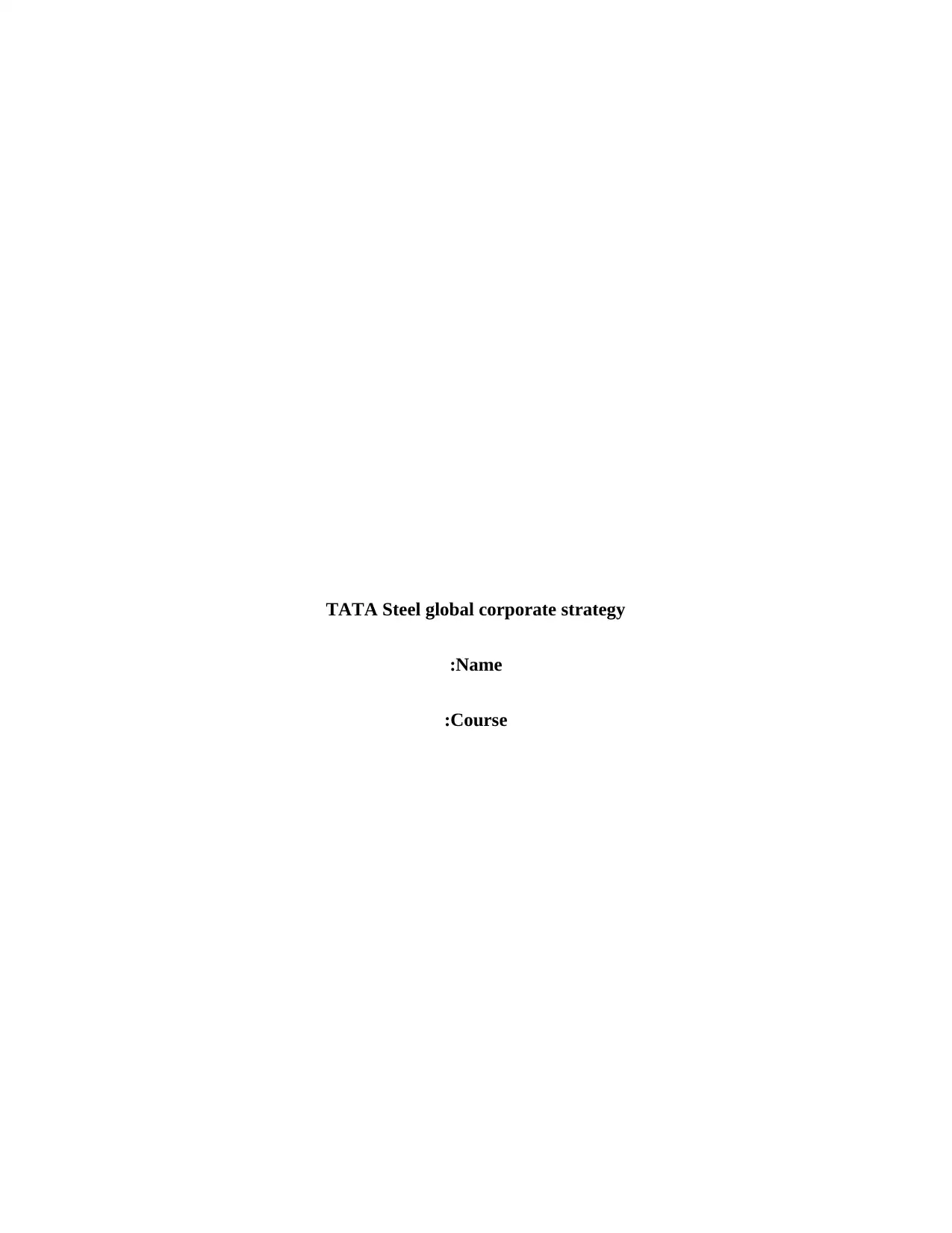
TATA Steel global corporate strategy
Name:
Course:
Name:
Course:
Secure Best Marks with AI Grader
Need help grading? Try our AI Grader for instant feedback on your assignments.
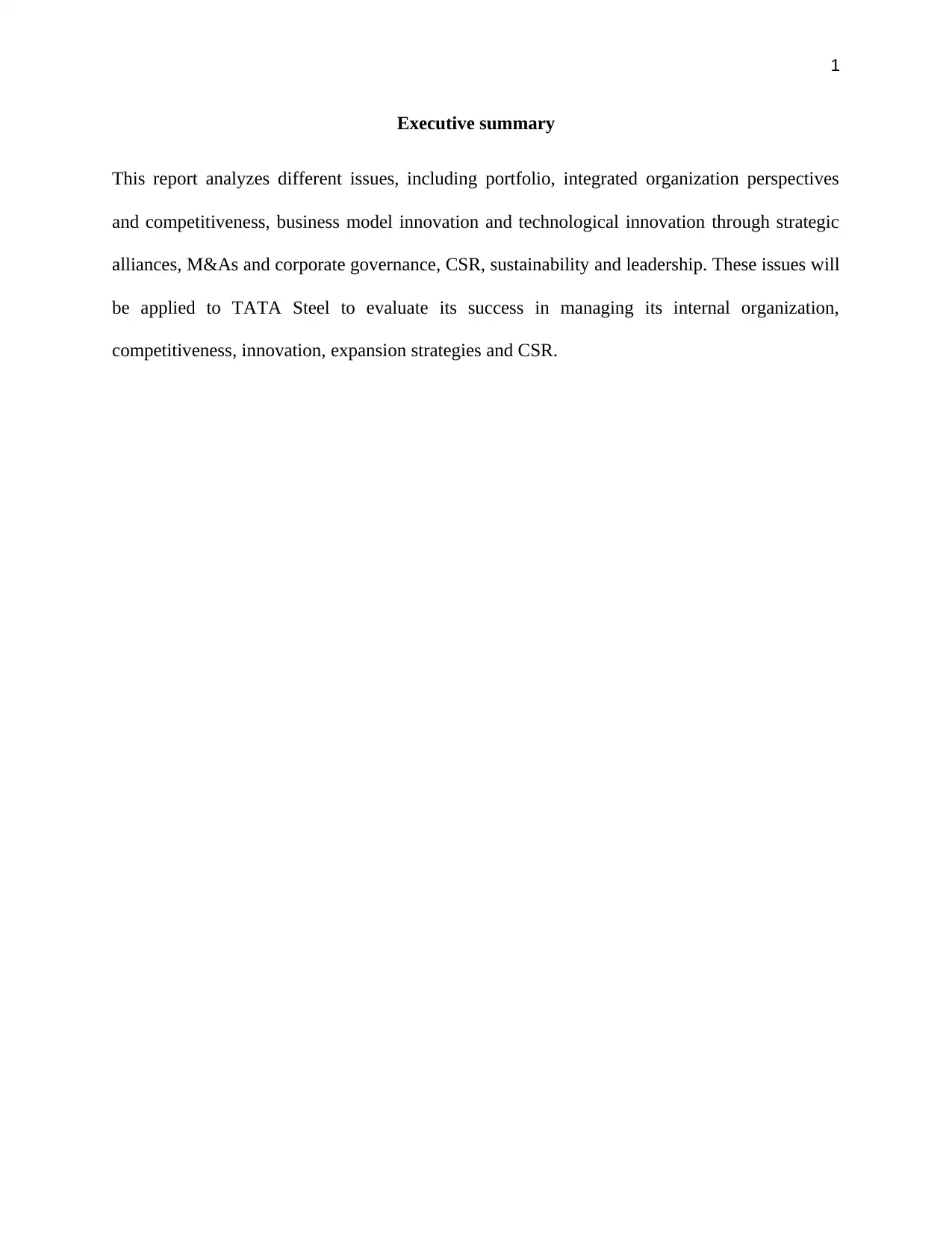
1
Executive summary
This report analyzes different issues, including portfolio, integrated organization perspectives
and competitiveness, business model innovation and technological innovation through strategic
alliances, M&As and corporate governance, CSR, sustainability and leadership. These issues will
be applied to TATA Steel to evaluate its success in managing its internal organization,
competitiveness, innovation, expansion strategies and CSR.
Executive summary
This report analyzes different issues, including portfolio, integrated organization perspectives
and competitiveness, business model innovation and technological innovation through strategic
alliances, M&As and corporate governance, CSR, sustainability and leadership. These issues will
be applied to TATA Steel to evaluate its success in managing its internal organization,
competitiveness, innovation, expansion strategies and CSR.

2
Table of Contents
Introduction....................................................................................................................................3
First: Portfolio, integrated organization perspectives and competitiveness............................4
1.1 The integrated organization perspective................................................................................4
1.2 The integrated portfolio management approach....................................................................6
1.3 TATA Steel integrated organization perspective versus the portfolio management approach
6
Second: Business model innovation and technological innovation through strategic
alliances, M&As.............................................................................................................................7
2.1 Business model innovation....................................................................................................7
2.2TATA Steel business innovation model.................................................................................9
2.3 TATA Steel M&A.................................................................................................................9
Third: Corporate governance, CSR, sustainability and leadership........................................10
3.1 Corporate governance..........................................................................................................10
3.2 Corporate governance in steel industry................................................................................10
3.3 TATA corporate governance philosophy.............................................................................11
3.4 Leadership in CSR...............................................................................................................11
3.5 TATA leadership in CSR.....................................................................................................12
Fourth: Personal reflections on learning and conclusions.......................................................12
References.....................................................................................................................................15
Table of Contents
Introduction....................................................................................................................................3
First: Portfolio, integrated organization perspectives and competitiveness............................4
1.1 The integrated organization perspective................................................................................4
1.2 The integrated portfolio management approach....................................................................6
1.3 TATA Steel integrated organization perspective versus the portfolio management approach
6
Second: Business model innovation and technological innovation through strategic
alliances, M&As.............................................................................................................................7
2.1 Business model innovation....................................................................................................7
2.2TATA Steel business innovation model.................................................................................9
2.3 TATA Steel M&A.................................................................................................................9
Third: Corporate governance, CSR, sustainability and leadership........................................10
3.1 Corporate governance..........................................................................................................10
3.2 Corporate governance in steel industry................................................................................10
3.3 TATA corporate governance philosophy.............................................................................11
3.4 Leadership in CSR...............................................................................................................11
3.5 TATA leadership in CSR.....................................................................................................12
Fourth: Personal reflections on learning and conclusions.......................................................12
References.....................................................................................................................................15
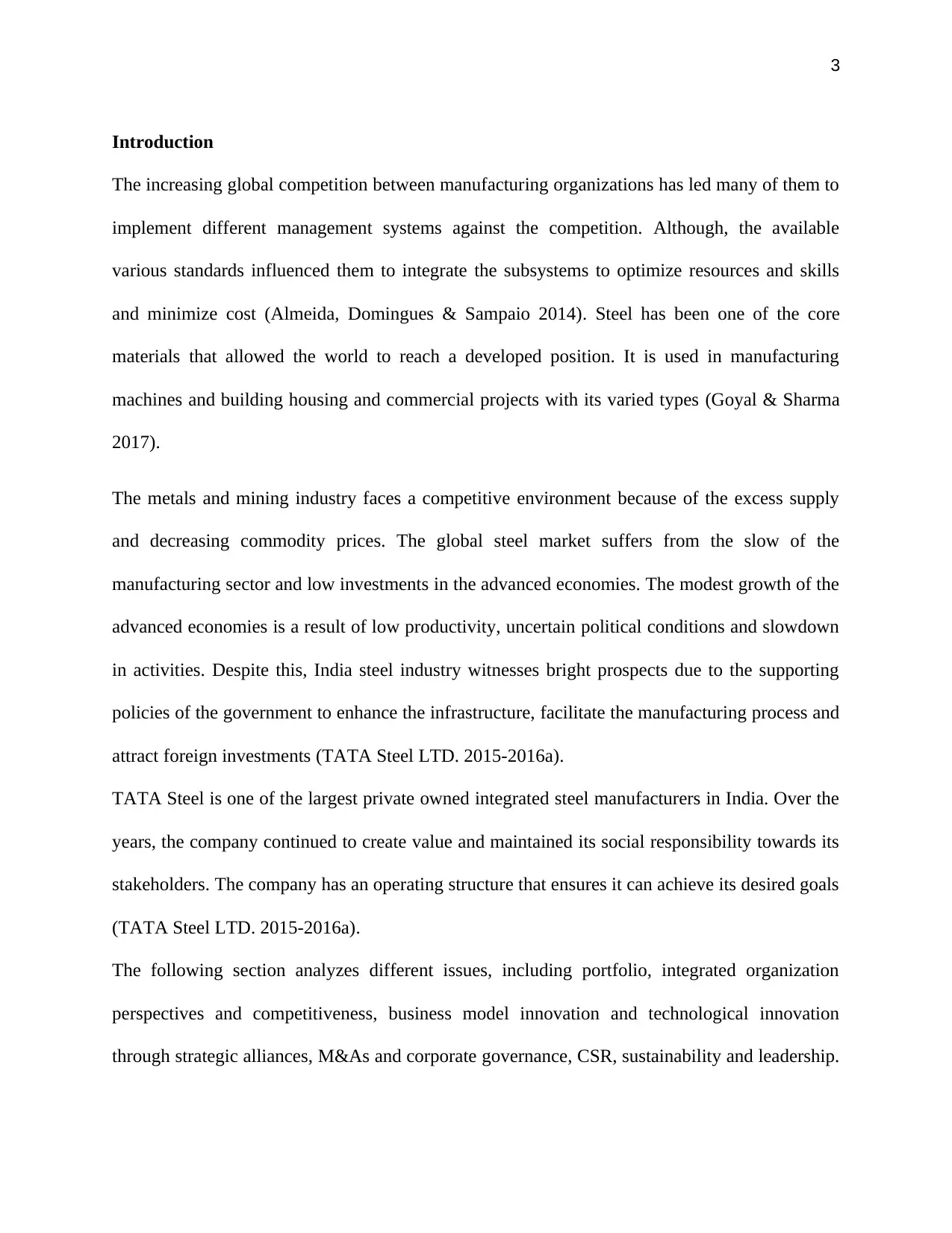
3
Introduction
The increasing global competition between manufacturing organizations has led many of them to
implement different management systems against the competition. Although, the available
various standards influenced them to integrate the subsystems to optimize resources and skills
and minimize cost (Almeida, Domingues & Sampaio 2014). Steel has been one of the core
materials that allowed the world to reach a developed position. It is used in manufacturing
machines and building housing and commercial projects with its varied types (Goyal & Sharma
2017).
The metals and mining industry faces a competitive environment because of the excess supply
and decreasing commodity prices. The global steel market suffers from the slow of the
manufacturing sector and low investments in the advanced economies. The modest growth of the
advanced economies is a result of low productivity, uncertain political conditions and slowdown
in activities. Despite this, India steel industry witnesses bright prospects due to the supporting
policies of the government to enhance the infrastructure, facilitate the manufacturing process and
attract foreign investments (TATA Steel LTD. 2015-2016a).
TATA Steel is one of the largest private owned integrated steel manufacturers in India. Over the
years, the company continued to create value and maintained its social responsibility towards its
stakeholders. The company has an operating structure that ensures it can achieve its desired goals
(TATA Steel LTD. 2015-2016a).
The following section analyzes different issues, including portfolio, integrated organization
perspectives and competitiveness, business model innovation and technological innovation
through strategic alliances, M&As and corporate governance, CSR, sustainability and leadership.
Introduction
The increasing global competition between manufacturing organizations has led many of them to
implement different management systems against the competition. Although, the available
various standards influenced them to integrate the subsystems to optimize resources and skills
and minimize cost (Almeida, Domingues & Sampaio 2014). Steel has been one of the core
materials that allowed the world to reach a developed position. It is used in manufacturing
machines and building housing and commercial projects with its varied types (Goyal & Sharma
2017).
The metals and mining industry faces a competitive environment because of the excess supply
and decreasing commodity prices. The global steel market suffers from the slow of the
manufacturing sector and low investments in the advanced economies. The modest growth of the
advanced economies is a result of low productivity, uncertain political conditions and slowdown
in activities. Despite this, India steel industry witnesses bright prospects due to the supporting
policies of the government to enhance the infrastructure, facilitate the manufacturing process and
attract foreign investments (TATA Steel LTD. 2015-2016a).
TATA Steel is one of the largest private owned integrated steel manufacturers in India. Over the
years, the company continued to create value and maintained its social responsibility towards its
stakeholders. The company has an operating structure that ensures it can achieve its desired goals
(TATA Steel LTD. 2015-2016a).
The following section analyzes different issues, including portfolio, integrated organization
perspectives and competitiveness, business model innovation and technological innovation
through strategic alliances, M&As and corporate governance, CSR, sustainability and leadership.
Secure Best Marks with AI Grader
Need help grading? Try our AI Grader for instant feedback on your assignments.
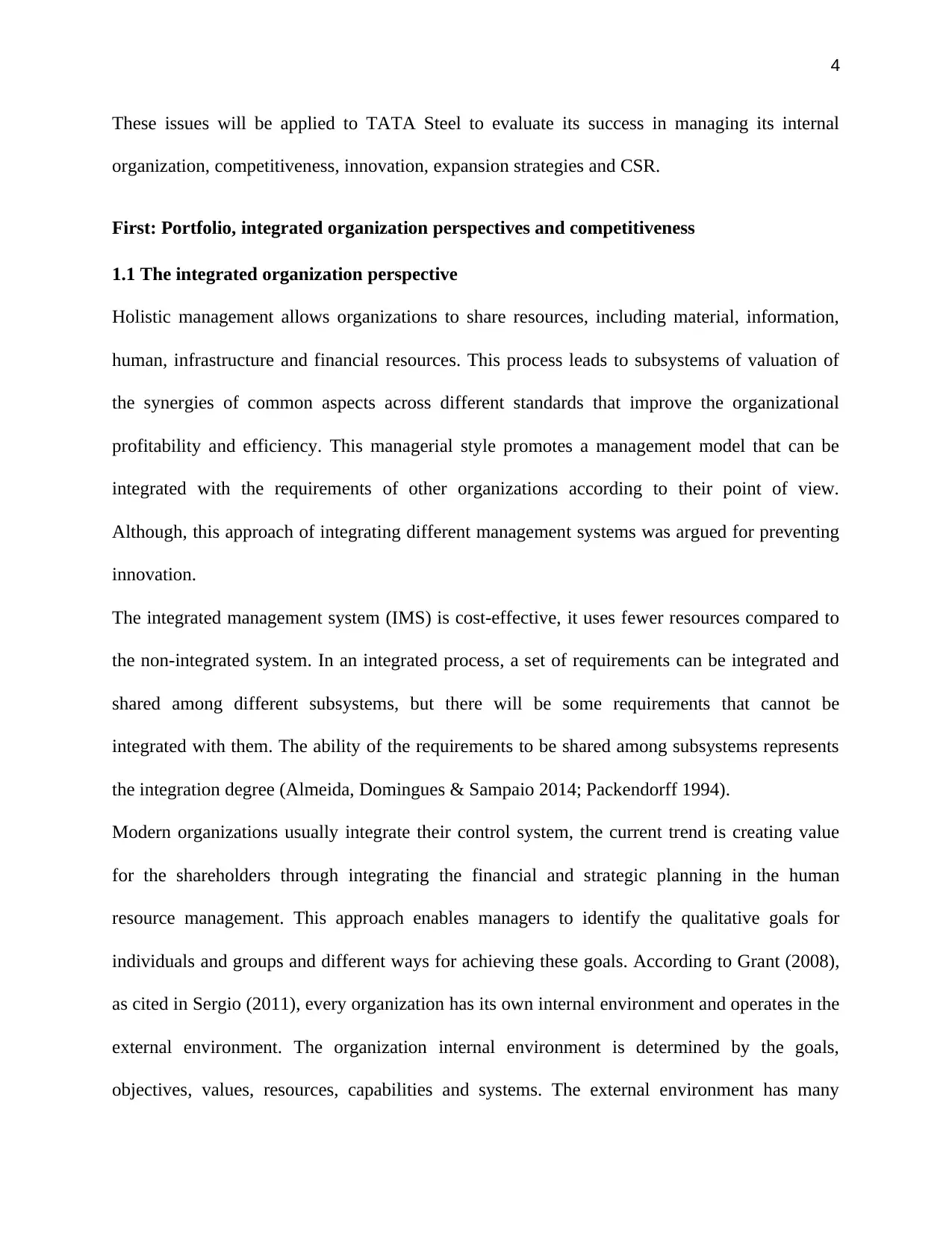
4
These issues will be applied to TATA Steel to evaluate its success in managing its internal
organization, competitiveness, innovation, expansion strategies and CSR.
First: Portfolio, integrated organization perspectives and competitiveness
1.1 The integrated organization perspective
Holistic management allows organizations to share resources, including material, information,
human, infrastructure and financial resources. This process leads to subsystems of valuation of
the synergies of common aspects across different standards that improve the organizational
profitability and efficiency. This managerial style promotes a management model that can be
integrated with the requirements of other organizations according to their point of view.
Although, this approach of integrating different management systems was argued for preventing
innovation.
The integrated management system (IMS) is cost-effective, it uses fewer resources compared to
the non-integrated system. In an integrated process, a set of requirements can be integrated and
shared among different subsystems, but there will be some requirements that cannot be
integrated with them. The ability of the requirements to be shared among subsystems represents
the integration degree (Almeida, Domingues & Sampaio 2014; Packendorff 1994).
Modern organizations usually integrate their control system, the current trend is creating value
for the shareholders through integrating the financial and strategic planning in the human
resource management. This approach enables managers to identify the qualitative goals for
individuals and groups and different ways for achieving these goals. According to Grant (2008),
as cited in Sergio (2011), every organization has its own internal environment and operates in the
external environment. The organization internal environment is determined by the goals,
objectives, values, resources, capabilities and systems. The external environment has many
These issues will be applied to TATA Steel to evaluate its success in managing its internal
organization, competitiveness, innovation, expansion strategies and CSR.
First: Portfolio, integrated organization perspectives and competitiveness
1.1 The integrated organization perspective
Holistic management allows organizations to share resources, including material, information,
human, infrastructure and financial resources. This process leads to subsystems of valuation of
the synergies of common aspects across different standards that improve the organizational
profitability and efficiency. This managerial style promotes a management model that can be
integrated with the requirements of other organizations according to their point of view.
Although, this approach of integrating different management systems was argued for preventing
innovation.
The integrated management system (IMS) is cost-effective, it uses fewer resources compared to
the non-integrated system. In an integrated process, a set of requirements can be integrated and
shared among different subsystems, but there will be some requirements that cannot be
integrated with them. The ability of the requirements to be shared among subsystems represents
the integration degree (Almeida, Domingues & Sampaio 2014; Packendorff 1994).
Modern organizations usually integrate their control system, the current trend is creating value
for the shareholders through integrating the financial and strategic planning in the human
resource management. This approach enables managers to identify the qualitative goals for
individuals and groups and different ways for achieving these goals. According to Grant (2008),
as cited in Sergio (2011), every organization has its own internal environment and operates in the
external environment. The organization internal environment is determined by the goals,
objectives, values, resources, capabilities and systems. The external environment has many
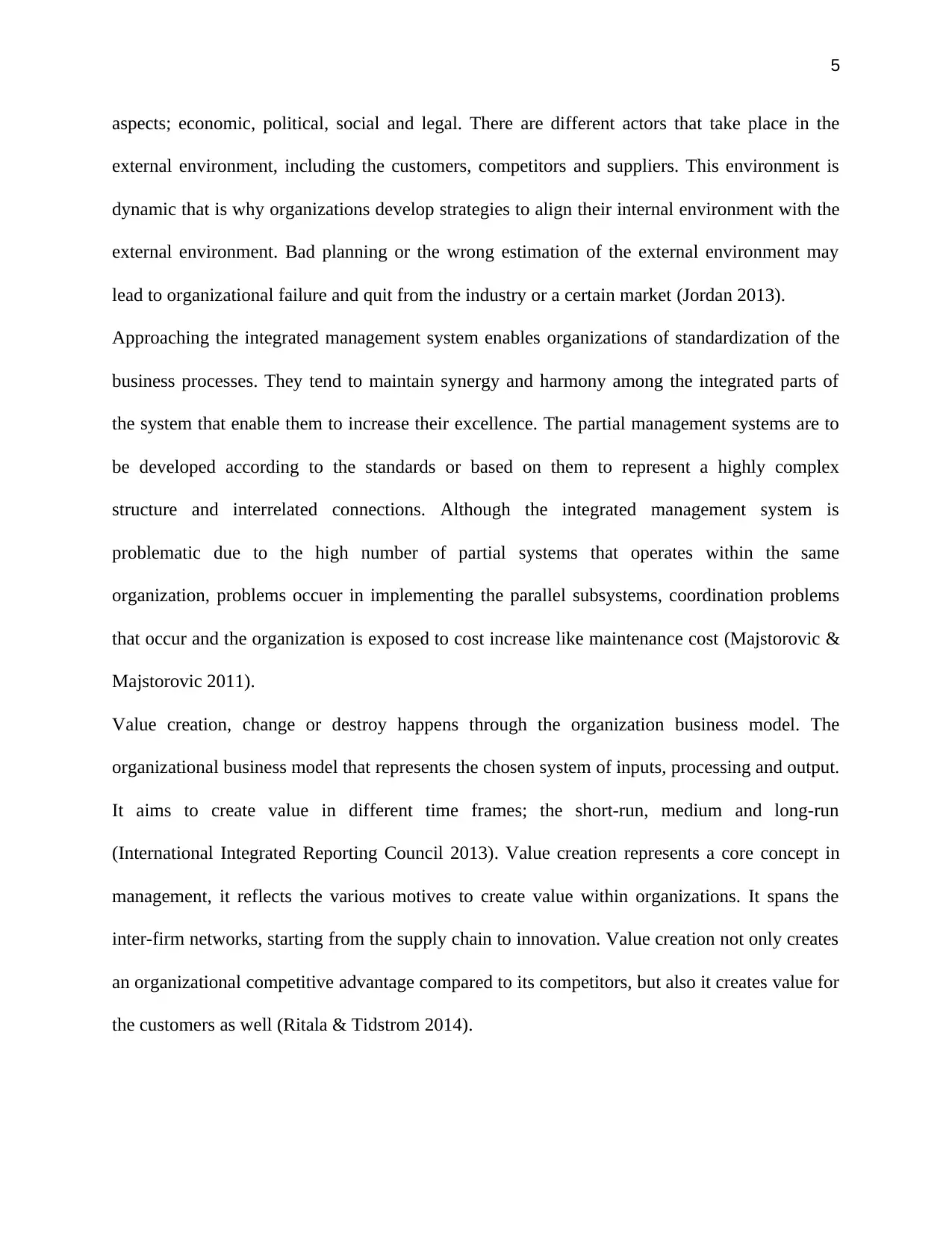
5
aspects; economic, political, social and legal. There are different actors that take place in the
external environment, including the customers, competitors and suppliers. This environment is
dynamic that is why organizations develop strategies to align their internal environment with the
external environment. Bad planning or the wrong estimation of the external environment may
lead to organizational failure and quit from the industry or a certain market (Jordan 2013).
Approaching the integrated management system enables organizations of standardization of the
business processes. They tend to maintain synergy and harmony among the integrated parts of
the system that enable them to increase their excellence. The partial management systems are to
be developed according to the standards or based on them to represent a highly complex
structure and interrelated connections. Although the integrated management system is
problematic due to the high number of partial systems that operates within the same
organization, problems occuer in implementing the parallel subsystems, coordination problems
that occur and the organization is exposed to cost increase like maintenance cost (Majstorovic &
Majstorovic 2011).
Value creation, change or destroy happens through the organization business model. The
organizational business model that represents the chosen system of inputs, processing and output.
It aims to create value in different time frames; the short-run, medium and long-run
(International Integrated Reporting Council 2013). Value creation represents a core concept in
management, it reflects the various motives to create value within organizations. It spans the
inter-firm networks, starting from the supply chain to innovation. Value creation not only creates
an organizational competitive advantage compared to its competitors, but also it creates value for
the customers as well (Ritala & Tidstrom 2014).
aspects; economic, political, social and legal. There are different actors that take place in the
external environment, including the customers, competitors and suppliers. This environment is
dynamic that is why organizations develop strategies to align their internal environment with the
external environment. Bad planning or the wrong estimation of the external environment may
lead to organizational failure and quit from the industry or a certain market (Jordan 2013).
Approaching the integrated management system enables organizations of standardization of the
business processes. They tend to maintain synergy and harmony among the integrated parts of
the system that enable them to increase their excellence. The partial management systems are to
be developed according to the standards or based on them to represent a highly complex
structure and interrelated connections. Although the integrated management system is
problematic due to the high number of partial systems that operates within the same
organization, problems occuer in implementing the parallel subsystems, coordination problems
that occur and the organization is exposed to cost increase like maintenance cost (Majstorovic &
Majstorovic 2011).
Value creation, change or destroy happens through the organization business model. The
organizational business model that represents the chosen system of inputs, processing and output.
It aims to create value in different time frames; the short-run, medium and long-run
(International Integrated Reporting Council 2013). Value creation represents a core concept in
management, it reflects the various motives to create value within organizations. It spans the
inter-firm networks, starting from the supply chain to innovation. Value creation not only creates
an organizational competitive advantage compared to its competitors, but also it creates value for
the customers as well (Ritala & Tidstrom 2014).

6
The integrated steel plant manufacturers' steel from the basic raw materials, like iron ore, coking
coal and fluxes. Raw material, sinter plant, blast furnace, light and medium merchant mills,
handling plants, coke ovens refractory material plant, steel melt shops, wire rod mills, structural
mills, special bar and structural mills and medium merchant represent the main production units.
The auxiliary units include engineering shops, power plant and oxygen plant. Steel the steel melt
shop represent the further refining facility, where blooms are produced (Acharyulu, Subbaiah &
Rao 2015).
1.2 The integrated portfolio management approach
The portfolio represents the collection of projects through which the organization transforms its
businesses. The organizational goals may include areas that are likely to move the organization
forward. The projects represent the part of work designed to achieve these goals, portfolio
management requires, projects prioritization according to the organizational goals, selection of
the projects that are aligned to the business goals, budget and available resources, flexibility of
correction according to changes in priorities and ensuring that the project output leads to the
business measurable outcomes. It is necessary for organizations to understand the environment in
which they operate and respond to its changes. According to the portfolio management approach,
every major project in any department should be aligned to the same overall portfolio
management approach. Every project manager should act in the same discipline and participate
in the same portfolio (Jordan 2013).
1.3 TATA Steel integrated organization perspective versus the portfolio management
approach
In accordance with the vision of Tata Steel, the company utilizes value creation and corporate
governance to aspires to be the global steel industry benchmark. The company conducts the
The integrated steel plant manufacturers' steel from the basic raw materials, like iron ore, coking
coal and fluxes. Raw material, sinter plant, blast furnace, light and medium merchant mills,
handling plants, coke ovens refractory material plant, steel melt shops, wire rod mills, structural
mills, special bar and structural mills and medium merchant represent the main production units.
The auxiliary units include engineering shops, power plant and oxygen plant. Steel the steel melt
shop represent the further refining facility, where blooms are produced (Acharyulu, Subbaiah &
Rao 2015).
1.2 The integrated portfolio management approach
The portfolio represents the collection of projects through which the organization transforms its
businesses. The organizational goals may include areas that are likely to move the organization
forward. The projects represent the part of work designed to achieve these goals, portfolio
management requires, projects prioritization according to the organizational goals, selection of
the projects that are aligned to the business goals, budget and available resources, flexibility of
correction according to changes in priorities and ensuring that the project output leads to the
business measurable outcomes. It is necessary for organizations to understand the environment in
which they operate and respond to its changes. According to the portfolio management approach,
every major project in any department should be aligned to the same overall portfolio
management approach. Every project manager should act in the same discipline and participate
in the same portfolio (Jordan 2013).
1.3 TATA Steel integrated organization perspective versus the portfolio management
approach
In accordance with the vision of Tata Steel, the company utilizes value creation and corporate
governance to aspires to be the global steel industry benchmark. The company conducts the
Paraphrase This Document
Need a fresh take? Get an instant paraphrase of this document with our AI Paraphraser

7
necessary activities to realize its vision by achieving its value creation goals, following safety
standards, respecting the environmental aspects and responds to societal needs (TATA Steel
LTD. 2015).
TATA process of value creation is achieved by converting the raw materials into customized
steel products that fulfill the customer needs. The business model represents the core value
creation, it represents the well-integrated operations of steel manufacturing starting from mining
to making steel and the other downstream processing. The produced output of flat and long
products and solid waste. It draws inputs from different sources of capital, enhances its
competitive position and brand image. The company maintains a long-term strategic focus on
value creation for the stakeholders. It also depends on innovation in product development to
adapt to the environmental changes through leveraging technology, improving resource
efficiency and increasing the utilization of solid waste. The global steel industry witness
oversupply and the sharp depreciation strategy of currencies adopted by some countries that
further complicated the problem. TATA Steel aligns its strategy to the group strategy that
resulted in its current adopted strategy of maintaining its leadership position in terms of
operational excellence and cost competitiveness. This strategy is accelerated through the
Shikhar-25 program that focuses on achieving 25% earnings before interest, taxes, depreciation,
and amortization compared at market priced raw material within 2-3 years. It is a multi-
divisional, multi-location, cross-functional improvement initiative that aims to excel across the
entire steel value chain (TATA Steel LTD. 2015-2016a). According to the previous analysis,
both forms of integrated organization perspective and the portfolio management approach are
applied within TATA steel.
necessary activities to realize its vision by achieving its value creation goals, following safety
standards, respecting the environmental aspects and responds to societal needs (TATA Steel
LTD. 2015).
TATA process of value creation is achieved by converting the raw materials into customized
steel products that fulfill the customer needs. The business model represents the core value
creation, it represents the well-integrated operations of steel manufacturing starting from mining
to making steel and the other downstream processing. The produced output of flat and long
products and solid waste. It draws inputs from different sources of capital, enhances its
competitive position and brand image. The company maintains a long-term strategic focus on
value creation for the stakeholders. It also depends on innovation in product development to
adapt to the environmental changes through leveraging technology, improving resource
efficiency and increasing the utilization of solid waste. The global steel industry witness
oversupply and the sharp depreciation strategy of currencies adopted by some countries that
further complicated the problem. TATA Steel aligns its strategy to the group strategy that
resulted in its current adopted strategy of maintaining its leadership position in terms of
operational excellence and cost competitiveness. This strategy is accelerated through the
Shikhar-25 program that focuses on achieving 25% earnings before interest, taxes, depreciation,
and amortization compared at market priced raw material within 2-3 years. It is a multi-
divisional, multi-location, cross-functional improvement initiative that aims to excel across the
entire steel value chain (TATA Steel LTD. 2015-2016a). According to the previous analysis,
both forms of integrated organization perspective and the portfolio management approach are
applied within TATA steel.
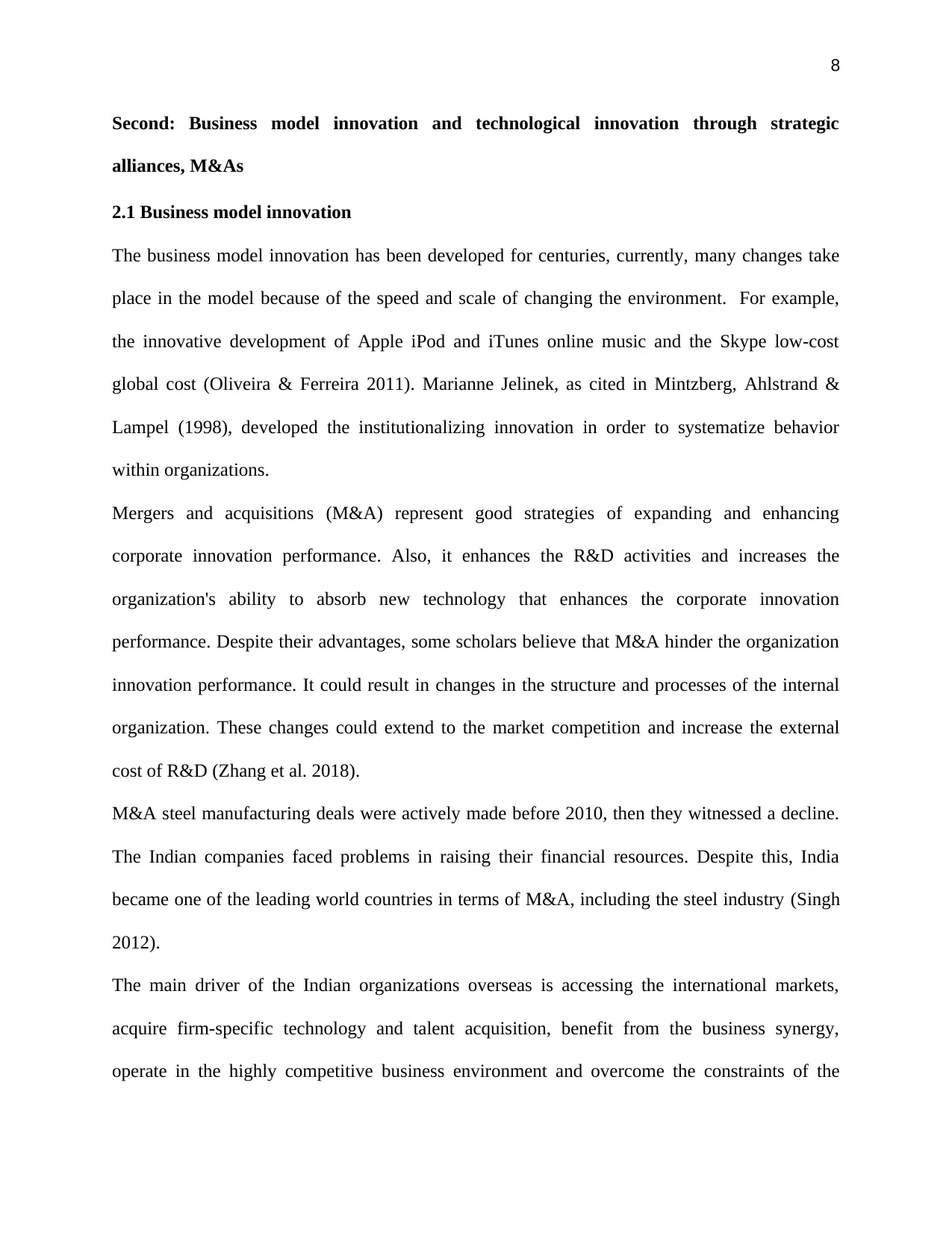
8
Second: Business model innovation and technological innovation through strategic
alliances, M&As
2.1 Business model innovation
The business model innovation has been developed for centuries, currently, many changes take
place in the model because of the speed and scale of changing the environment. For example,
the innovative development of Apple iPod and iTunes online music and the Skype low-cost
global cost (Oliveira & Ferreira 2011). Marianne Jelinek, as cited in Mintzberg, Ahlstrand &
Lampel (1998), developed the institutionalizing innovation in order to systematize behavior
within organizations.
Mergers and acquisitions (M&A) represent good strategies of expanding and enhancing
corporate innovation performance. Also, it enhances the R&D activities and increases the
organization's ability to absorb new technology that enhances the corporate innovation
performance. Despite their advantages, some scholars believe that M&A hinder the organization
innovation performance. It could result in changes in the structure and processes of the internal
organization. These changes could extend to the market competition and increase the external
cost of R&D (Zhang et al. 2018).
M&A steel manufacturing deals were actively made before 2010, then they witnessed a decline.
The Indian companies faced problems in raising their financial resources. Despite this, India
became one of the leading world countries in terms of M&A, including the steel industry (Singh
2012).
The main driver of the Indian organizations overseas is accessing the international markets,
acquire firm-specific technology and talent acquisition, benefit from the business synergy,
operate in the highly competitive business environment and overcome the constraints of the
Second: Business model innovation and technological innovation through strategic
alliances, M&As
2.1 Business model innovation
The business model innovation has been developed for centuries, currently, many changes take
place in the model because of the speed and scale of changing the environment. For example,
the innovative development of Apple iPod and iTunes online music and the Skype low-cost
global cost (Oliveira & Ferreira 2011). Marianne Jelinek, as cited in Mintzberg, Ahlstrand &
Lampel (1998), developed the institutionalizing innovation in order to systematize behavior
within organizations.
Mergers and acquisitions (M&A) represent good strategies of expanding and enhancing
corporate innovation performance. Also, it enhances the R&D activities and increases the
organization's ability to absorb new technology that enhances the corporate innovation
performance. Despite their advantages, some scholars believe that M&A hinder the organization
innovation performance. It could result in changes in the structure and processes of the internal
organization. These changes could extend to the market competition and increase the external
cost of R&D (Zhang et al. 2018).
M&A steel manufacturing deals were actively made before 2010, then they witnessed a decline.
The Indian companies faced problems in raising their financial resources. Despite this, India
became one of the leading world countries in terms of M&A, including the steel industry (Singh
2012).
The main driver of the Indian organizations overseas is accessing the international markets,
acquire firm-specific technology and talent acquisition, benefit from the business synergy,
operate in the highly competitive business environment and overcome the constraints of the
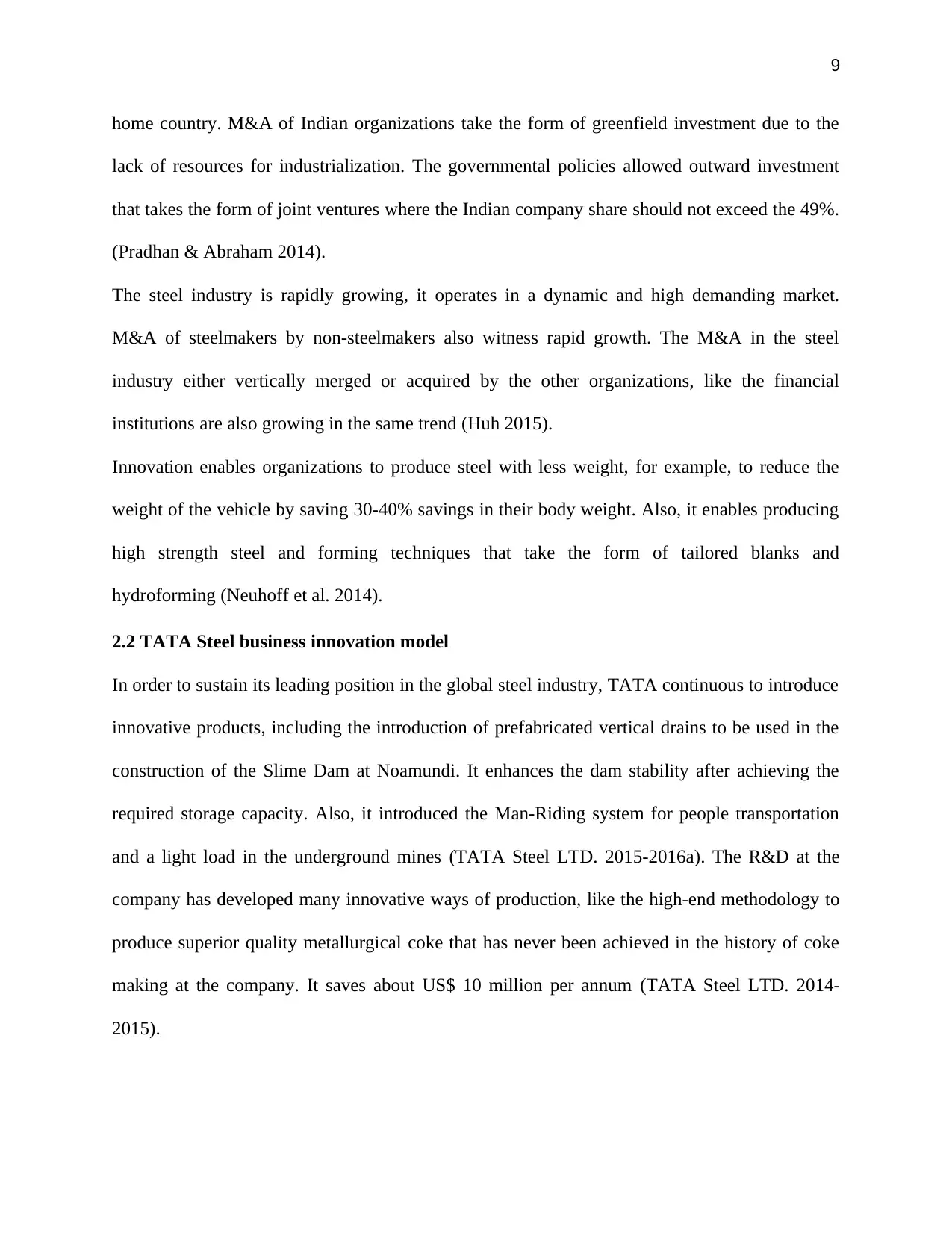
9
home country. M&A of Indian organizations take the form of greenfield investment due to the
lack of resources for industrialization. The governmental policies allowed outward investment
that takes the form of joint ventures where the Indian company share should not exceed the 49%.
(Pradhan & Abraham 2014).
The steel industry is rapidly growing, it operates in a dynamic and high demanding market.
M&A of steelmakers by non-steelmakers also witness rapid growth. The M&A in the steel
industry either vertically merged or acquired by the other organizations, like the financial
institutions are also growing in the same trend (Huh 2015).
Innovation enables organizations to produce steel with less weight, for example, to reduce the
weight of the vehicle by saving 30-40% savings in their body weight. Also, it enables producing
high strength steel and forming techniques that take the form of tailored blanks and
hydroforming (Neuhoff et al. 2014).
2.2 TATA Steel business innovation model
In order to sustain its leading position in the global steel industry, TATA continuous to introduce
innovative products, including the introduction of prefabricated vertical drains to be used in the
construction of the Slime Dam at Noamundi. It enhances the dam stability after achieving the
required storage capacity. Also, it introduced the Man-Riding system for people transportation
and a light load in the underground mines (TATA Steel LTD. 2015-2016a). The R&D at the
company has developed many innovative ways of production, like the high-end methodology to
produce superior quality metallurgical coke that has never been achieved in the history of coke
making at the company. It saves about US$ 10 million per annum (TATA Steel LTD. 2014-
2015).
home country. M&A of Indian organizations take the form of greenfield investment due to the
lack of resources for industrialization. The governmental policies allowed outward investment
that takes the form of joint ventures where the Indian company share should not exceed the 49%.
(Pradhan & Abraham 2014).
The steel industry is rapidly growing, it operates in a dynamic and high demanding market.
M&A of steelmakers by non-steelmakers also witness rapid growth. The M&A in the steel
industry either vertically merged or acquired by the other organizations, like the financial
institutions are also growing in the same trend (Huh 2015).
Innovation enables organizations to produce steel with less weight, for example, to reduce the
weight of the vehicle by saving 30-40% savings in their body weight. Also, it enables producing
high strength steel and forming techniques that take the form of tailored blanks and
hydroforming (Neuhoff et al. 2014).
2.2 TATA Steel business innovation model
In order to sustain its leading position in the global steel industry, TATA continuous to introduce
innovative products, including the introduction of prefabricated vertical drains to be used in the
construction of the Slime Dam at Noamundi. It enhances the dam stability after achieving the
required storage capacity. Also, it introduced the Man-Riding system for people transportation
and a light load in the underground mines (TATA Steel LTD. 2015-2016a). The R&D at the
company has developed many innovative ways of production, like the high-end methodology to
produce superior quality metallurgical coke that has never been achieved in the history of coke
making at the company. It saves about US$ 10 million per annum (TATA Steel LTD. 2014-
2015).
Secure Best Marks with AI Grader
Need help grading? Try our AI Grader for instant feedback on your assignments.
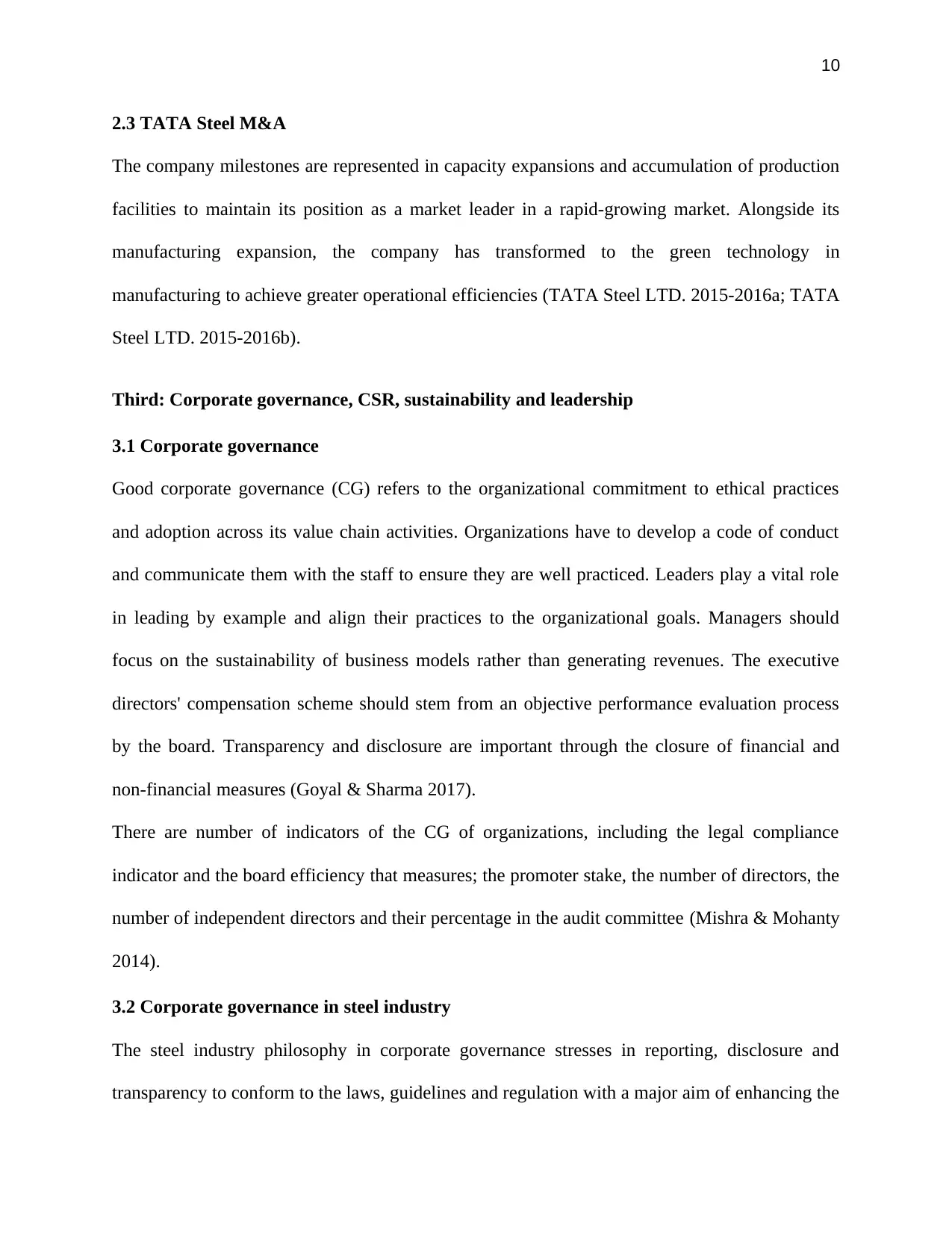
10
2.3 TATA Steel M&A
The company milestones are represented in capacity expansions and accumulation of production
facilities to maintain its position as a market leader in a rapid-growing market. Alongside its
manufacturing expansion, the company has transformed to the green technology in
manufacturing to achieve greater operational efficiencies (TATA Steel LTD. 2015-2016a; TATA
Steel LTD. 2015-2016b).
Third: Corporate governance, CSR, sustainability and leadership
3.1 Corporate governance
Good corporate governance (CG) refers to the organizational commitment to ethical practices
and adoption across its value chain activities. Organizations have to develop a code of conduct
and communicate them with the staff to ensure they are well practiced. Leaders play a vital role
in leading by example and align their practices to the organizational goals. Managers should
focus on the sustainability of business models rather than generating revenues. The executive
directors' compensation scheme should stem from an objective performance evaluation process
by the board. Transparency and disclosure are important through the closure of financial and
non-financial measures (Goyal & Sharma 2017).
There are number of indicators of the CG of organizations, including the legal compliance
indicator and the board efficiency that measures; the promoter stake, the number of directors, the
number of independent directors and their percentage in the audit committee (Mishra & Mohanty
2014).
3.2 Corporate governance in steel industry
The steel industry philosophy in corporate governance stresses in reporting, disclosure and
transparency to conform to the laws, guidelines and regulation with a major aim of enhancing the
2.3 TATA Steel M&A
The company milestones are represented in capacity expansions and accumulation of production
facilities to maintain its position as a market leader in a rapid-growing market. Alongside its
manufacturing expansion, the company has transformed to the green technology in
manufacturing to achieve greater operational efficiencies (TATA Steel LTD. 2015-2016a; TATA
Steel LTD. 2015-2016b).
Third: Corporate governance, CSR, sustainability and leadership
3.1 Corporate governance
Good corporate governance (CG) refers to the organizational commitment to ethical practices
and adoption across its value chain activities. Organizations have to develop a code of conduct
and communicate them with the staff to ensure they are well practiced. Leaders play a vital role
in leading by example and align their practices to the organizational goals. Managers should
focus on the sustainability of business models rather than generating revenues. The executive
directors' compensation scheme should stem from an objective performance evaluation process
by the board. Transparency and disclosure are important through the closure of financial and
non-financial measures (Goyal & Sharma 2017).
There are number of indicators of the CG of organizations, including the legal compliance
indicator and the board efficiency that measures; the promoter stake, the number of directors, the
number of independent directors and their percentage in the audit committee (Mishra & Mohanty
2014).
3.2 Corporate governance in steel industry
The steel industry philosophy in corporate governance stresses in reporting, disclosure and
transparency to conform to the laws, guidelines and regulation with a major aim of enhancing the

11
shareholders' value. The companies in the steel industry aim for the overall welfare of all of the
system constituents. They have laid a strong foundation for sustaining corporate governance as
an everyday life experience. They form core groups of top-level executives and company leading
professionals of technology and innovation (Goyal & Sharma 2017; Pauliuk & Müller 2014).
3.3 TATA corporate governance philosophy
TATA steel founder was a nation builder rather than a profit seeker. The social capital for TATA
has a high importance that is represented in the formal and informal subsidiaries of the company.
They act to serve the nation, states, local communities and the ecosystem. The company is
socially accountable respect the law and human rights. The company action policies were
changed from giving to the society to creating an enabling environment and creating self-
sustained communities. It spends about 204 crores on the social activities and it encourages its
partners and employees to be socially committed through the volunteering programs guided by
the company (TATA Steel LTD. 2015-2016a).
Tata Steel CG follows best practices and guidance, it considers disclosure as their inherent
responsibility. It maintains timely and accurate information delivery to its stakeholders regarding
finance, performance and leadership. The board has adopted the guidelines of their effectiveness
in order to fulfill the CG responsibility towards stakeholders. The board has the required
authority to evaluate the company operations and make decisions independent from the
management to keep the company's long-term commitment towards its stakeholders. The board-
level stakeholders' relationship committee role is to examine and redress the shareholders'
complaints and disclose the status to the entire board. Also, the company encourages and funds
the green initiatives undertaken by the Ministry of Corporate Affairs (TATA Steel LTD. 2015).
shareholders' value. The companies in the steel industry aim for the overall welfare of all of the
system constituents. They have laid a strong foundation for sustaining corporate governance as
an everyday life experience. They form core groups of top-level executives and company leading
professionals of technology and innovation (Goyal & Sharma 2017; Pauliuk & Müller 2014).
3.3 TATA corporate governance philosophy
TATA steel founder was a nation builder rather than a profit seeker. The social capital for TATA
has a high importance that is represented in the formal and informal subsidiaries of the company.
They act to serve the nation, states, local communities and the ecosystem. The company is
socially accountable respect the law and human rights. The company action policies were
changed from giving to the society to creating an enabling environment and creating self-
sustained communities. It spends about 204 crores on the social activities and it encourages its
partners and employees to be socially committed through the volunteering programs guided by
the company (TATA Steel LTD. 2015-2016a).
Tata Steel CG follows best practices and guidance, it considers disclosure as their inherent
responsibility. It maintains timely and accurate information delivery to its stakeholders regarding
finance, performance and leadership. The board has adopted the guidelines of their effectiveness
in order to fulfill the CG responsibility towards stakeholders. The board has the required
authority to evaluate the company operations and make decisions independent from the
management to keep the company's long-term commitment towards its stakeholders. The board-
level stakeholders' relationship committee role is to examine and redress the shareholders'
complaints and disclose the status to the entire board. Also, the company encourages and funds
the green initiatives undertaken by the Ministry of Corporate Affairs (TATA Steel LTD. 2015).
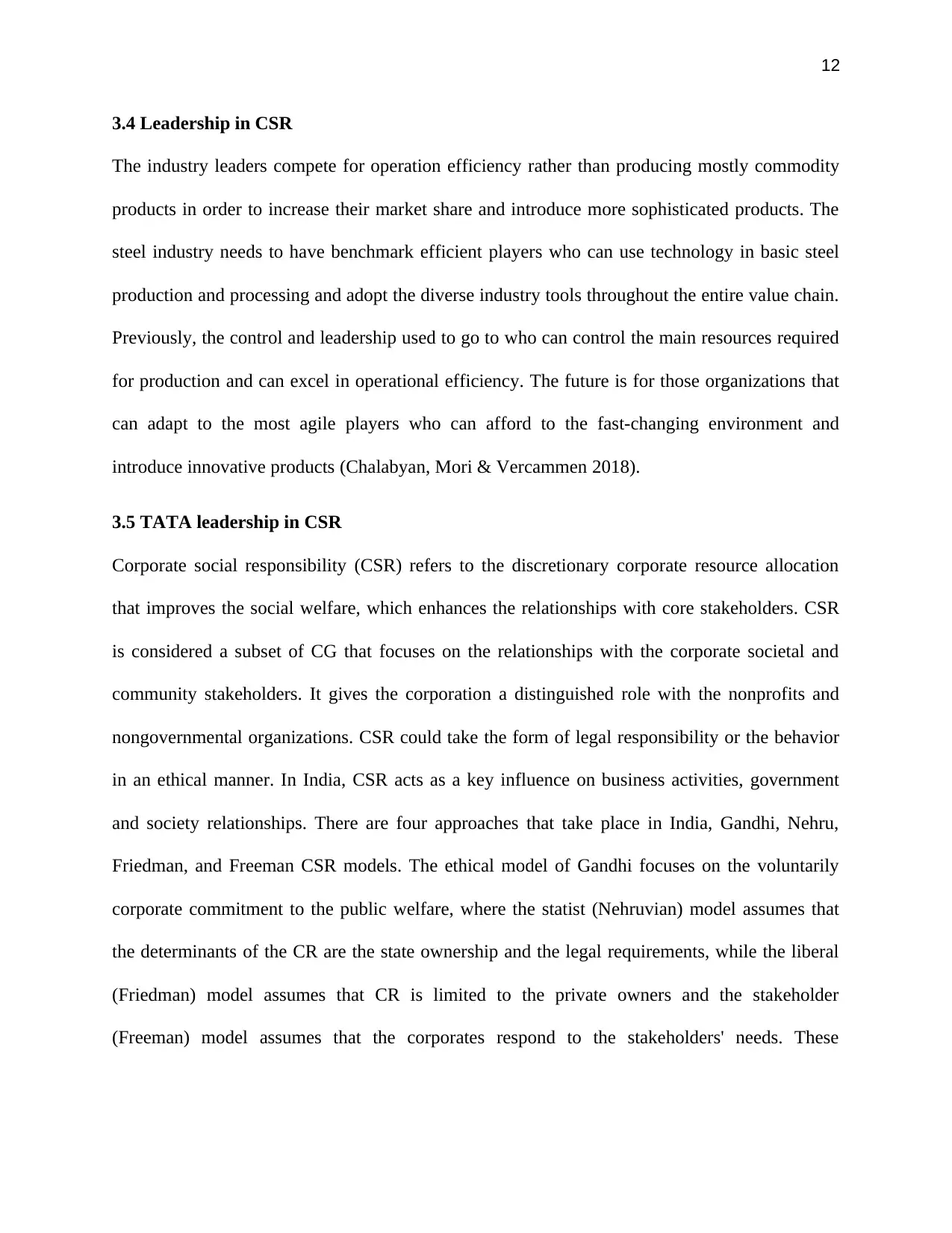
12
3.4 Leadership in CSR
The industry leaders compete for operation efficiency rather than producing mostly commodity
products in order to increase their market share and introduce more sophisticated products. The
steel industry needs to have benchmark efficient players who can use technology in basic steel
production and processing and adopt the diverse industry tools throughout the entire value chain.
Previously, the control and leadership used to go to who can control the main resources required
for production and can excel in operational efficiency. The future is for those organizations that
can adapt to the most agile players who can afford to the fast-changing environment and
introduce innovative products (Chalabyan, Mori & Vercammen 2018).
3.5 TATA leadership in CSR
Corporate social responsibility (CSR) refers to the discretionary corporate resource allocation
that improves the social welfare, which enhances the relationships with core stakeholders. CSR
is considered a subset of CG that focuses on the relationships with the corporate societal and
community stakeholders. It gives the corporation a distinguished role with the nonprofits and
nongovernmental organizations. CSR could take the form of legal responsibility or the behavior
in an ethical manner. In India, CSR acts as a key influence on business activities, government
and society relationships. There are four approaches that take place in India, Gandhi, Nehru,
Friedman, and Freeman CSR models. The ethical model of Gandhi focuses on the voluntarily
corporate commitment to the public welfare, where the statist (Nehruvian) model assumes that
the determinants of the CR are the state ownership and the legal requirements, while the liberal
(Friedman) model assumes that CR is limited to the private owners and the stakeholder
(Freeman) model assumes that the corporates respond to the stakeholders' needs. These
3.4 Leadership in CSR
The industry leaders compete for operation efficiency rather than producing mostly commodity
products in order to increase their market share and introduce more sophisticated products. The
steel industry needs to have benchmark efficient players who can use technology in basic steel
production and processing and adopt the diverse industry tools throughout the entire value chain.
Previously, the control and leadership used to go to who can control the main resources required
for production and can excel in operational efficiency. The future is for those organizations that
can adapt to the most agile players who can afford to the fast-changing environment and
introduce innovative products (Chalabyan, Mori & Vercammen 2018).
3.5 TATA leadership in CSR
Corporate social responsibility (CSR) refers to the discretionary corporate resource allocation
that improves the social welfare, which enhances the relationships with core stakeholders. CSR
is considered a subset of CG that focuses on the relationships with the corporate societal and
community stakeholders. It gives the corporation a distinguished role with the nonprofits and
nongovernmental organizations. CSR could take the form of legal responsibility or the behavior
in an ethical manner. In India, CSR acts as a key influence on business activities, government
and society relationships. There are four approaches that take place in India, Gandhi, Nehru,
Friedman, and Freeman CSR models. The ethical model of Gandhi focuses on the voluntarily
corporate commitment to the public welfare, where the statist (Nehruvian) model assumes that
the determinants of the CR are the state ownership and the legal requirements, while the liberal
(Friedman) model assumes that CR is limited to the private owners and the stakeholder
(Freeman) model assumes that the corporates respond to the stakeholders' needs. These
Paraphrase This Document
Need a fresh take? Get an instant paraphrase of this document with our AI Paraphraser
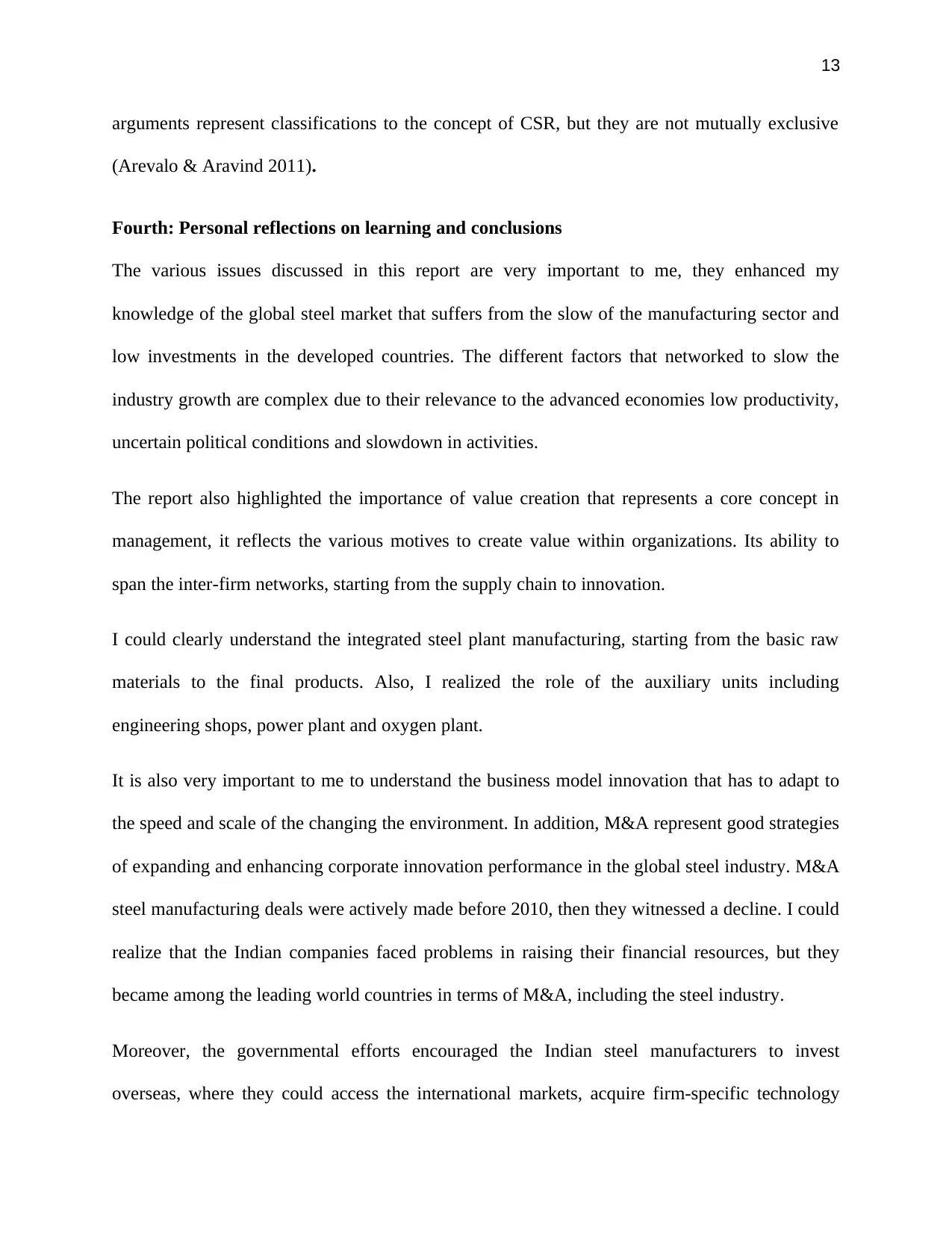
13
arguments represent classifications to the concept of CSR, but they are not mutually exclusive
(Arevalo & Aravind 2011).
Fourth: Personal reflections on learning and conclusions
The various issues discussed in this report are very important to me, they enhanced my
knowledge of the global steel market that suffers from the slow of the manufacturing sector and
low investments in the developed countries. The different factors that networked to slow the
industry growth are complex due to their relevance to the advanced economies low productivity,
uncertain political conditions and slowdown in activities.
The report also highlighted the importance of value creation that represents a core concept in
management, it reflects the various motives to create value within organizations. Its ability to
span the inter-firm networks, starting from the supply chain to innovation.
I could clearly understand the integrated steel plant manufacturing, starting from the basic raw
materials to the final products. Also, I realized the role of the auxiliary units including
engineering shops, power plant and oxygen plant.
It is also very important to me to understand the business model innovation that has to adapt to
the speed and scale of the changing the environment. In addition, M&A represent good strategies
of expanding and enhancing corporate innovation performance in the global steel industry. M&A
steel manufacturing deals were actively made before 2010, then they witnessed a decline. I could
realize that the Indian companies faced problems in raising their financial resources, but they
became among the leading world countries in terms of M&A, including the steel industry.
Moreover, the governmental efforts encouraged the Indian steel manufacturers to invest
overseas, where they could access the international markets, acquire firm-specific technology
arguments represent classifications to the concept of CSR, but they are not mutually exclusive
(Arevalo & Aravind 2011).
Fourth: Personal reflections on learning and conclusions
The various issues discussed in this report are very important to me, they enhanced my
knowledge of the global steel market that suffers from the slow of the manufacturing sector and
low investments in the developed countries. The different factors that networked to slow the
industry growth are complex due to their relevance to the advanced economies low productivity,
uncertain political conditions and slowdown in activities.
The report also highlighted the importance of value creation that represents a core concept in
management, it reflects the various motives to create value within organizations. Its ability to
span the inter-firm networks, starting from the supply chain to innovation.
I could clearly understand the integrated steel plant manufacturing, starting from the basic raw
materials to the final products. Also, I realized the role of the auxiliary units including
engineering shops, power plant and oxygen plant.
It is also very important to me to understand the business model innovation that has to adapt to
the speed and scale of the changing the environment. In addition, M&A represent good strategies
of expanding and enhancing corporate innovation performance in the global steel industry. M&A
steel manufacturing deals were actively made before 2010, then they witnessed a decline. I could
realize that the Indian companies faced problems in raising their financial resources, but they
became among the leading world countries in terms of M&A, including the steel industry.
Moreover, the governmental efforts encouraged the Indian steel manufacturers to invest
overseas, where they could access the international markets, acquire firm-specific technology

14
and talent acquisition, benefit from the business synergy, operate in the highly competitive
business environment and overcome the constraints of the home country. M&A of Indian
organizations take the form of greenfield investment due to the lack of resources for
industrialization.
In addition, I could generally understand the CG philosophy and the specific Indian CG and steel
industry philosophy, disclosure and transparency to conform to the laws, guidelines and
regulation with a major aim of enhancing the shareholders' value. It was interesting to realize the
fact that the companies in the steel industry aim for the overall welfare of all of the system
constituents and they could lay a strong foundation for sustaining CG as an everyday life
experience.
and talent acquisition, benefit from the business synergy, operate in the highly competitive
business environment and overcome the constraints of the home country. M&A of Indian
organizations take the form of greenfield investment due to the lack of resources for
industrialization.
In addition, I could generally understand the CG philosophy and the specific Indian CG and steel
industry philosophy, disclosure and transparency to conform to the laws, guidelines and
regulation with a major aim of enhancing the shareholders' value. It was interesting to realize the
fact that the companies in the steel industry aim for the overall welfare of all of the system
constituents and they could lay a strong foundation for sustaining CG as an everyday life
experience.
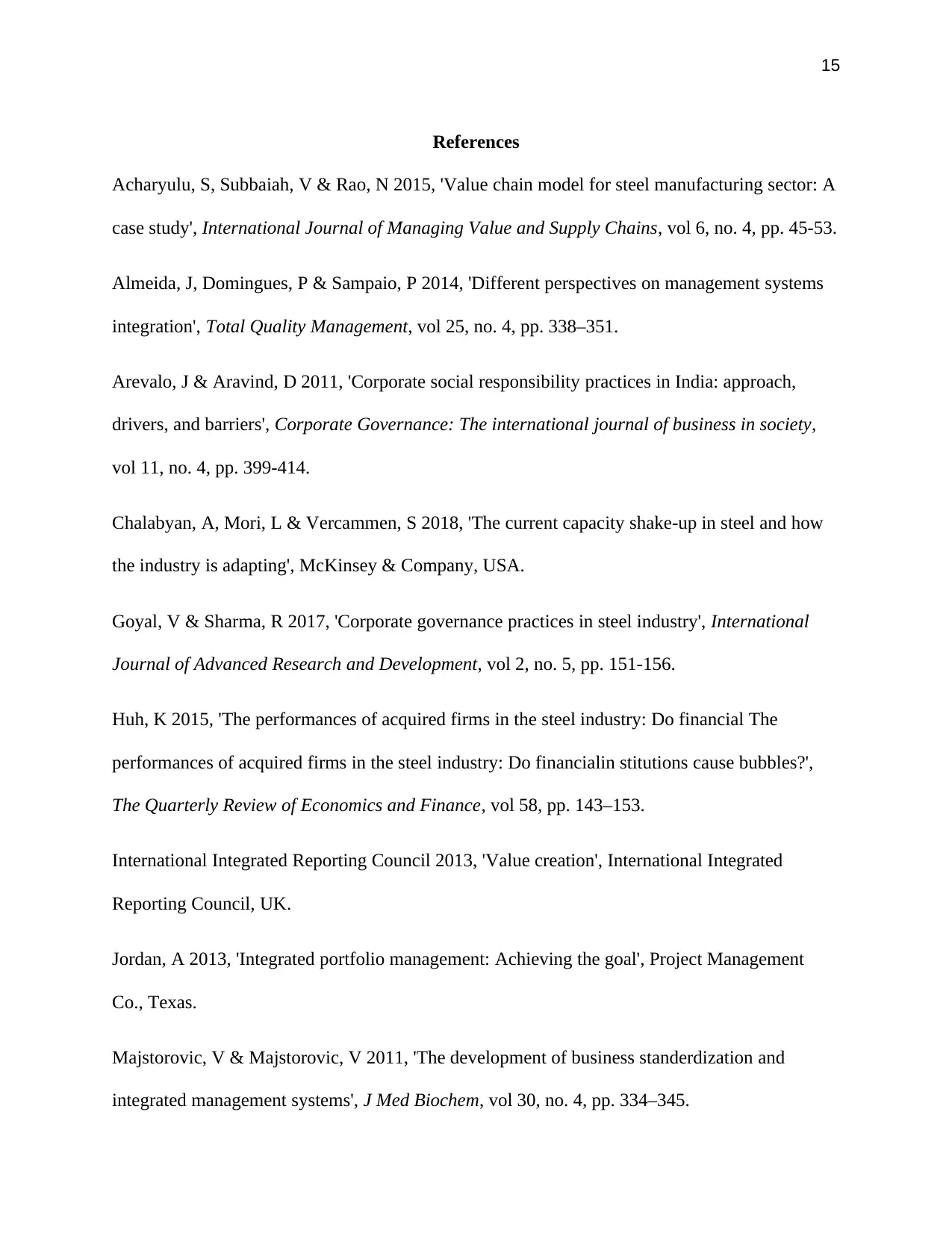
15
References
Acharyulu, S, Subbaiah, V & Rao, N 2015, 'Value chain model for steel manufacturing sector: A
case study', International Journal of Managing Value and Supply Chains, vol 6, no. 4, pp. 45-53.
Almeida, J, Domingues, P & Sampaio, P 2014, 'Different perspectives on management systems
integration', Total Quality Management, vol 25, no. 4, pp. 338–351.
Arevalo, J & Aravind, D 2011, 'Corporate social responsibility practices in India: approach,
drivers, and barriers', Corporate Governance: The international journal of business in society,
vol 11, no. 4, pp. 399-414.
Chalabyan, A, Mori, L & Vercammen, S 2018, 'The current capacity shake-up in steel and how
the industry is adapting', McKinsey & Company, USA.
Goyal, V & Sharma, R 2017, 'Corporate governance practices in steel industry', International
Journal of Advanced Research and Development, vol 2, no. 5, pp. 151-156.
Huh, K 2015, 'The performances of acquired firms in the steel industry: Do financial The
performances of acquired firms in the steel industry: Do financialin stitutions cause bubbles?',
The Quarterly Review of Economics and Finance, vol 58, pp. 143–153.
International Integrated Reporting Council 2013, 'Value creation', International Integrated
Reporting Council, UK.
Jordan, A 2013, 'Integrated portfolio management: Achieving the goal', Project Management
Co., Texas.
Majstorovic, V & Majstorovic, V 2011, 'The development of business standerdization and
integrated management systems', J Med Biochem, vol 30, no. 4, pp. 334–345.
References
Acharyulu, S, Subbaiah, V & Rao, N 2015, 'Value chain model for steel manufacturing sector: A
case study', International Journal of Managing Value and Supply Chains, vol 6, no. 4, pp. 45-53.
Almeida, J, Domingues, P & Sampaio, P 2014, 'Different perspectives on management systems
integration', Total Quality Management, vol 25, no. 4, pp. 338–351.
Arevalo, J & Aravind, D 2011, 'Corporate social responsibility practices in India: approach,
drivers, and barriers', Corporate Governance: The international journal of business in society,
vol 11, no. 4, pp. 399-414.
Chalabyan, A, Mori, L & Vercammen, S 2018, 'The current capacity shake-up in steel and how
the industry is adapting', McKinsey & Company, USA.
Goyal, V & Sharma, R 2017, 'Corporate governance practices in steel industry', International
Journal of Advanced Research and Development, vol 2, no. 5, pp. 151-156.
Huh, K 2015, 'The performances of acquired firms in the steel industry: Do financial The
performances of acquired firms in the steel industry: Do financialin stitutions cause bubbles?',
The Quarterly Review of Economics and Finance, vol 58, pp. 143–153.
International Integrated Reporting Council 2013, 'Value creation', International Integrated
Reporting Council, UK.
Jordan, A 2013, 'Integrated portfolio management: Achieving the goal', Project Management
Co., Texas.
Majstorovic, V & Majstorovic, V 2011, 'The development of business standerdization and
integrated management systems', J Med Biochem, vol 30, no. 4, pp. 334–345.
Secure Best Marks with AI Grader
Need help grading? Try our AI Grader for instant feedback on your assignments.
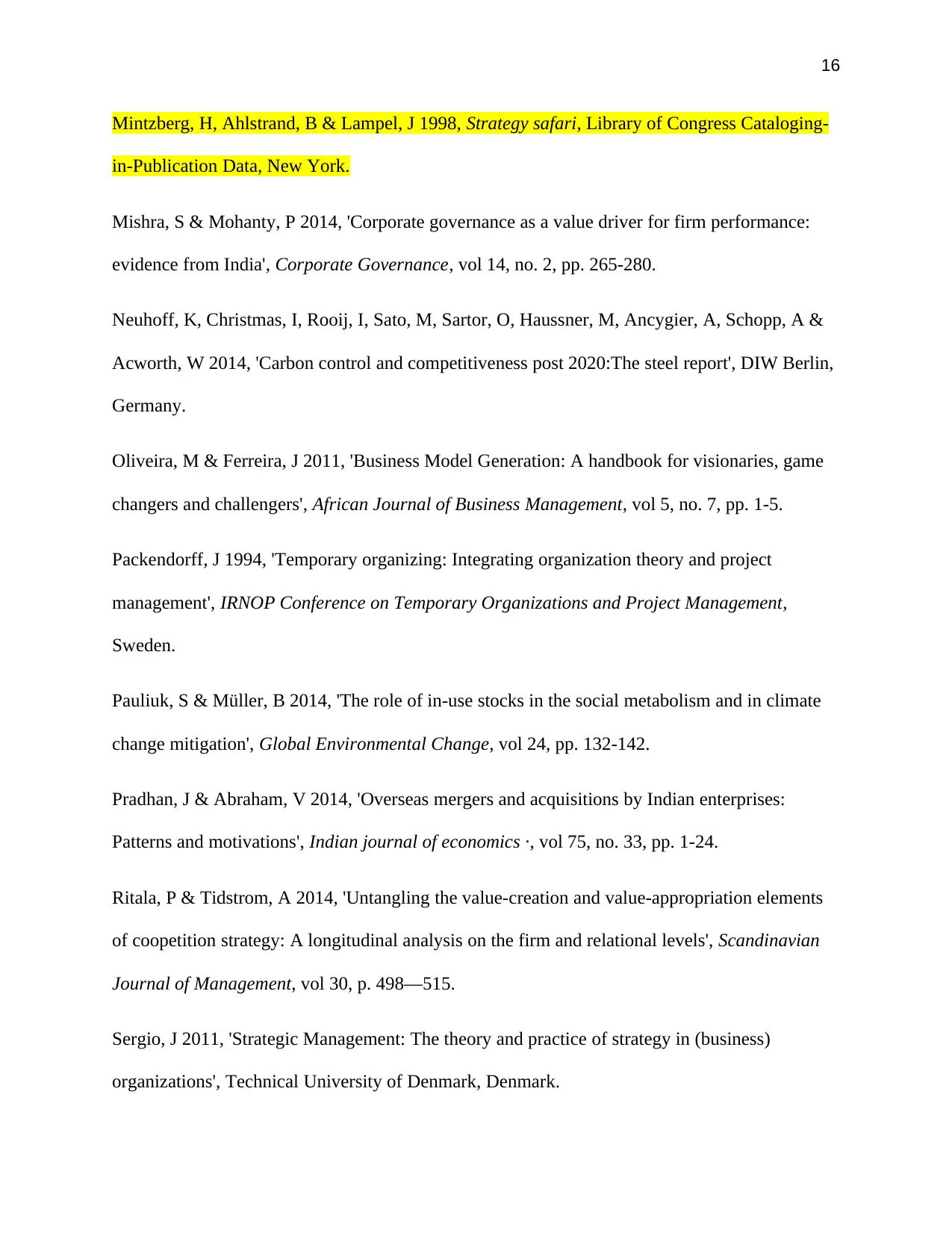
16
Mintzberg, H, Ahlstrand, B & Lampel, J 1998, Strategy safari, Library of Congress Cataloging-
in-Publication Data, New York.
Mishra, S & Mohanty, P 2014, 'Corporate governance as a value driver for firm performance:
evidence from India', Corporate Governance, vol 14, no. 2, pp. 265-280.
Neuhoff, K, Christmas, I, Rooij, I, Sato, M, Sartor, O, Haussner, M, Ancygier, A, Schopp, A &
Acworth, W 2014, 'Carbon control and competitiveness post 2020:The steel report', DIW Berlin,
Germany.
Oliveira, M & Ferreira, J 2011, 'Business Model Generation: A handbook for visionaries, game
changers and challengers', African Journal of Business Management, vol 5, no. 7, pp. 1-5.
Packendorff, J 1994, 'Temporary organizing: Integrating organization theory and project
management', IRNOP Conference on Temporary Organizations and Project Management,
Sweden.
Pauliuk, S & Müller, B 2014, 'The role of in-use stocks in the social metabolism and in climate
change mitigation', Global Environmental Change, vol 24, pp. 132-142.
Pradhan, J & Abraham, V 2014, 'Overseas mergers and acquisitions by Indian enterprises:
Patterns and motivations', Indian journal of economics ·, vol 75, no. 33, pp. 1-24.
Ritala, P & Tidstrom, A 2014, 'Untangling the value-creation and value-appropriation elements
of coopetition strategy: A longitudinal analysis on the firm and relational levels', Scandinavian
Journal of Management, vol 30, p. 498—515.
Sergio, J 2011, 'Strategic Management: The theory and practice of strategy in (business)
organizations', Technical University of Denmark, Denmark.
Mintzberg, H, Ahlstrand, B & Lampel, J 1998, Strategy safari, Library of Congress Cataloging-
in-Publication Data, New York.
Mishra, S & Mohanty, P 2014, 'Corporate governance as a value driver for firm performance:
evidence from India', Corporate Governance, vol 14, no. 2, pp. 265-280.
Neuhoff, K, Christmas, I, Rooij, I, Sato, M, Sartor, O, Haussner, M, Ancygier, A, Schopp, A &
Acworth, W 2014, 'Carbon control and competitiveness post 2020:The steel report', DIW Berlin,
Germany.
Oliveira, M & Ferreira, J 2011, 'Business Model Generation: A handbook for visionaries, game
changers and challengers', African Journal of Business Management, vol 5, no. 7, pp. 1-5.
Packendorff, J 1994, 'Temporary organizing: Integrating organization theory and project
management', IRNOP Conference on Temporary Organizations and Project Management,
Sweden.
Pauliuk, S & Müller, B 2014, 'The role of in-use stocks in the social metabolism and in climate
change mitigation', Global Environmental Change, vol 24, pp. 132-142.
Pradhan, J & Abraham, V 2014, 'Overseas mergers and acquisitions by Indian enterprises:
Patterns and motivations', Indian journal of economics ·, vol 75, no. 33, pp. 1-24.
Ritala, P & Tidstrom, A 2014, 'Untangling the value-creation and value-appropriation elements
of coopetition strategy: A longitudinal analysis on the firm and relational levels', Scandinavian
Journal of Management, vol 30, p. 498—515.
Sergio, J 2011, 'Strategic Management: The theory and practice of strategy in (business)
organizations', Technical University of Denmark, Denmark.
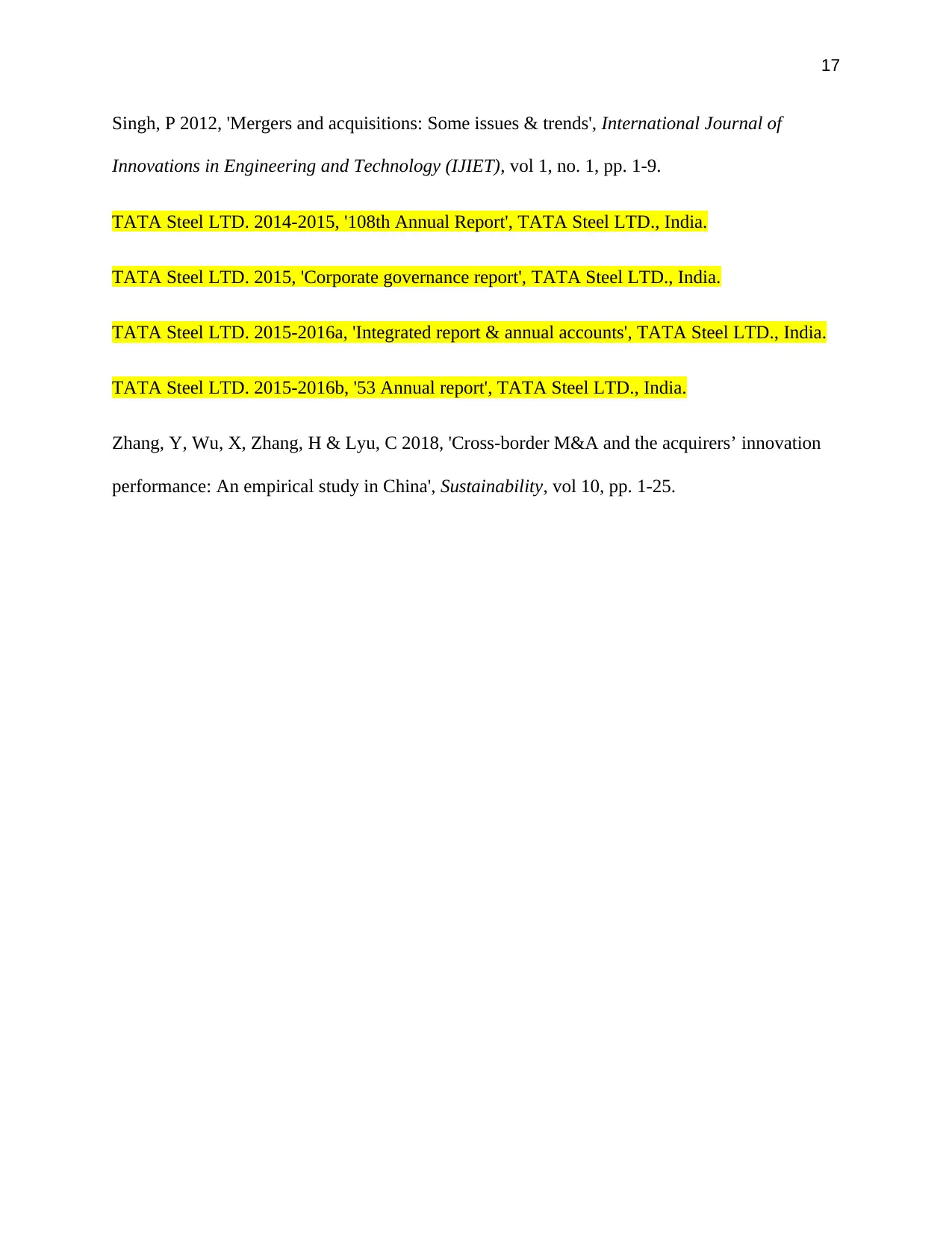
17
Singh, P 2012, 'Mergers and acquisitions: Some issues & trends', International Journal of
Innovations in Engineering and Technology (IJIET), vol 1, no. 1, pp. 1-9.
TATA Steel LTD. 2014-2015, '108th Annual Report', TATA Steel LTD., India.
TATA Steel LTD. 2015, 'Corporate governance report', TATA Steel LTD., India.
TATA Steel LTD. 2015-2016a, 'Integrated report & annual accounts', TATA Steel LTD., India.
TATA Steel LTD. 2015-2016b, '53 Annual report', TATA Steel LTD., India.
Zhang, Y, Wu, X, Zhang, H & Lyu, C 2018, 'Cross-border M&A and the acquirers’ innovation
performance: An empirical study in China', Sustainability, vol 10, pp. 1-25.
Singh, P 2012, 'Mergers and acquisitions: Some issues & trends', International Journal of
Innovations in Engineering and Technology (IJIET), vol 1, no. 1, pp. 1-9.
TATA Steel LTD. 2014-2015, '108th Annual Report', TATA Steel LTD., India.
TATA Steel LTD. 2015, 'Corporate governance report', TATA Steel LTD., India.
TATA Steel LTD. 2015-2016a, 'Integrated report & annual accounts', TATA Steel LTD., India.
TATA Steel LTD. 2015-2016b, '53 Annual report', TATA Steel LTD., India.
Zhang, Y, Wu, X, Zhang, H & Lyu, C 2018, 'Cross-border M&A and the acquirers’ innovation
performance: An empirical study in China', Sustainability, vol 10, pp. 1-25.
1 out of 18
Related Documents
Your All-in-One AI-Powered Toolkit for Academic Success.
+13062052269
info@desklib.com
Available 24*7 on WhatsApp / Email
![[object Object]](/_next/static/media/star-bottom.7253800d.svg)
Unlock your academic potential
© 2024 | Zucol Services PVT LTD | All rights reserved.





